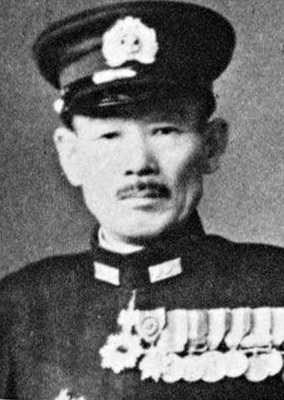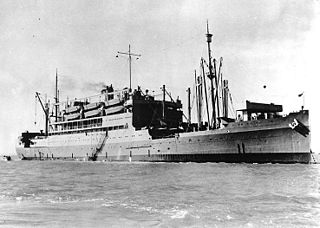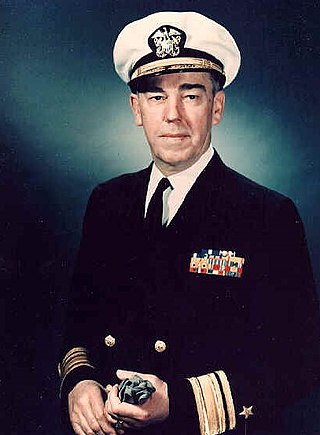
The naval Battle of the Eastern Solomons took place on 24–25 August 1942 and was the third carrier battle of the Pacific campaign of World War II and the second major engagement fought between the United States Navy and the Imperial Japanese Navy (IJN) during the Guadalcanal campaign. As at the Battle of the Coral Sea and the Battle of Midway, the ships of the two adversaries were never within sight of each other. Instead, all attacks were carried out by carrier-based or land-based aircraft.

USS Juneau (CL-52) was a United States Navy Atlanta-class light cruiser torpedoed and sunk at the Naval Battle of Guadalcanal on 13 November 1942. In total, 687 officers and sailors, including the five Sullivan brothers, were killed in action as a result of her sinking. Only 10 survivors were rescued after eight days in the water. To honor the five Sullivan brothers and Juneau, the U.S. Navy has since commissioned two ships named USS The Sullivans and two ships named USS Juneau. On 17 March 2018, Paul Allen's research crew on board RV Petrel located the wreck of Juneau at a depth of about 4,200 m (13,800 ft) off the Solomon Islands.

The Naval Battle of Guadalcanal, sometimes referred to as the Third and Fourth Battles of Savo Island, the Battle of the Solomons, TheBattle of Friday the 13th, The Night of the Big Guns, or, in Japanese sources, the Third Battle of the Solomon Sea, took place from 12 to 15 November 1942 and was the decisive engagement in a series of naval battles between Allied and Imperial Japanese forces during the months-long Guadalcanal campaign in the Solomon Islands during World War II. The action consisted of combined air and sea engagements over four days, most near Guadalcanal and all related to a Japanese effort to reinforce land forces on the island. The only two U.S. Navy admirals to be killed in a surface engagement in the war were lost in this battle.

The Battle of the Santa Cruz Islands, fought during 25–27 October 1942, sometimes referred to as the Battle of Santa Cruz or Third Battle of Solomon Sea, in Japan as the Battle of the South Pacific, was the fourth aircraft carrier battle of the Pacific campaign of World War II. It was also the fourth major naval engagement fought between the United States Navy and the Imperial Japanese Navy during the lengthy and strategically important Guadalcanal campaign. As in the battles of the Coral Sea, Midway, and the Eastern Solomons, the ships of the two adversaries were rarely in sight or gun range of each other. Instead, almost all attacks by both sides were mounted by carrier- or land-based aircraft.

Hiei (比叡) was a warship of the Imperial Japanese Navy during World War I and World War II. Designed by British naval architect George Thurston, she was the second launched of four Kongō-class battlecruisers, among the most heavily armed ships in any navy when built. Laid down in 1911 at the Yokosuka Naval Arsenal, Hiei was formally commissioned in 1914. She patrolled off the Chinese coast on several occasions during World War I, and helped with rescue efforts following the 1923 Great Kantō earthquake.

USS Fletcher (DD/DDE-445), named for Admiral Frank Friday Fletcher, was the lead Fletcher-class destroyer, and served in the Pacific during World War II. She received fifteen battle stars for World War II service, and five for Korean War service.

USS Aaron Ward (DD-483) was a Gleaves-class destroyer in the service of the United States Navy. She was the second Navy ship named in honor of Rear Admiral Aaron Ward. She sank on 7 April 1943 in a shoal near Tinete Point of Nggela Sule, Solomon Islands during Operation I-Go. Her wreck was discovered on 4 September 1994.

Kirishima (霧島) was a warship of the Imperial Japanese Navy which saw service during World War I and World War II. Designed by British naval engineer George Thurston, she was the third launched of the four Kongō-class battlecruisers. Laid down in 1912 at the Mitsubishi Shipyards in Nagasaki, Kirishima was formally commissioned in 1915 on the same day as her sister ship, Haruna. Kirishima patrolled on occasion off the Chinese coast during World War I, and helped with rescue efforts following the 1923 Great Kantō earthquake.

Yukikaze was a Kagerō-class destroyer in service with the Imperial Japanese Navy during World War II. She was the only member of her class to survive the war, and did so without suffering any major damage. She is famously known as a very fortunate ship, as she often survived numerous major naval encounters with little to no damage, while many of her allied ships would leave the battle crippled or sunk on multiple occasions. She did not accomplish anything of note in the battles of Java Sea, Midway, and Santa Cruz, but came to her own in various naval engagements in the Guadalcanal campaign, before seeing escorting missions during the Battle of the Philippine Sea, partaking in her last major surface engagement in the Battle of Leyte Gulf, and seeing her last major action of any sort escorting the battleship Yamato during the Battle of Okinawa. Following the war, the ship was transferred to the Republic of China Navy, where she was renamed Dan Yang and served until 1966, before being scrapped in 1970.

USS O'Bannon (DD/DDE-450), a Fletcher-class destroyer, was the second ship of the United States Navy to be named after Lieutenant Presley O'Bannon (1784–1850), the Marine Corps's "hero of Derna".

Hiroaki Abe was an admiral in the Imperial Japanese Navy during World War II.

USS Gwin (DD-433), a Gleaves-class destroyer, was the third ship of the United States Navy to be named for Lieutenant Commander William Gwin, an American Civil War officer who commanded river boats against Confederate forces in Alabama.

USS Monssen (DD-436), a Gleaves-class destroyer, was the first ship of the United States Navy to be named for Mons Monssen, who was awarded the Medal of Honor for his actions aboard USS Missouri (BB-11) in 1904. Commissioned in 1941, the destroyer saw service during World War II in both Atlantic and Pacific Oceans. Monssen was sunk at the Naval Battle of Guadalcanal on 13 November 1942.

USS Buchanan (DD-484), a Gleaves-class destroyer, was the second ship of the United States Navy to be named for Franklin Buchanan, who was an officer in the U.S. Navy who became an admiral in the Confederate Navy during the American Civil War.

USS McCawley (APA-4) was a McCawley-class attack transport that served with the United States Navy during World War II. Named after Charles G. McCawley, eighth Commandant of the U.S. Marine Corps, she was the lead ship in her class.

USS Sterett (DD-407) was a Benham-class destroyer in the United States Navy. She was the second Navy ship named for Andrew Sterett.

USS Barton (DD-599) was a Benson-class destroyer in the United States Navy during World War II. She was the first ship named for Rear Admiral John Kennedy Barton.

Nagara (長良) was the lead ship of her class of light cruiser in the Imperial Japanese Navy. She was named after the Nagara River in the Chūbu region of Japan.

Teruzuki was the second of 13 Akizuki-class destroyers built for the Imperial Japanese Navy (IJN) during the 1940s. The Akizuki-class ships were given a heavy armament of eight dual-purpose guns to fulfill their designed role as aircraft carrier escorts, although the design was modified with additional weapons to improve their flexibility. Completed in mid-1942, Teruzuki played a minor role in the Battle of the Santa Cruz Islands in October. The following month she participated in the Naval Battle of Guadalcanal, crippling several American warships, without taking any damage herself. The ship was sunk in December by American patrol torpedo boats as she escorted a convoy delivering supplies to the Japanese troops on Guadalcanal.

Rear Admiral Frederick Julian Becton was a decorated United States Navy officer. He is probably best remembered for commanding the destroyer USS Laffey (DD-724) in World War II during an intense Japanese kamikaze attack.




















